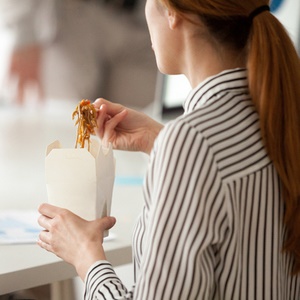
Lunch is the second most important meal of the day. It, however, ends up being the meal we tend to neglect due to poor planning and shopping practices as well as work constraints.
The following guidelines will help you to feel more energetic and avoid the energy dip we often experience around between three and four in the afternoon.
1. In the cafeteria or deli/salad bar
If you're watching your waistline, and depending on your family lifestyle, you need to decide if lunch is going to be your main meal of the day or just something light to see you through until dinner.
A main meal: If lunch is your main meal, it is wise to keep your protein (fish, chicken, lean beef) and starch portions (rice, potatoes) small and fill half of your plate with vegetables and salads.
This practice will result in a plate packed with fibre, phytonutrients (found in plant foods) and vitamins while remaining low in calories. Should the gravy look fatty, rather swap this for a small dollop of tomato sauce or chutney for extra taste.
A lighter meal: Although it's the middle of winter, our midday temperatures are usually high enough for a crunchy salad. The challenge is to keep it interesting.
Create your own salad: A nutritious salad bowl should consist of a healthy source of protein, carbohydrates, vegetables and fat. By combining the items below you can achieve this objective. Some cafeterias have a large variety of ingredients, but if your choice is limited, use the cafeteria salad as a base and bring additional ingredients from home.
Add a nutritious source of protein:
- Boiled egg
- Chicken
- Canned fish (tuna chunks, mackerel, salmon, pilchards in tomato sauce, drained sardines)
- Low-fat cheese (ricotta, cottage cheese, mozzarella)
- Sliced lean cold meats (ham, pastrami)
These choices are low in saturated fat and the fish is high in healthy omega-3 fatty acids.
Now add a portion of healthy carbohydrates:
- Corn kernels (canned or frozen)
- Brown or wild rice (leftovers)
- Chickpeas
- Lentils
- Beans (canned)
- Quinoa
- Wholegrain couscous
- Bulgur wheat
- Sweet potato
- Baby potatoes
Some of you favourite vegetables:
- Beetroot
- Tomatoes
- Broccoli florets
- Green beans
- Gherkins
- Cabbage
- Carrots
- Mangetout
- Lettuce
- Cucumber
- Leftover vegetables (peas, roasted butternut etc.)
One portion of fat:
- “Lite” mayonnaise
- Avocado
- Olive oil and lemon juice
- Vinegar
- Commercial low-oil vinaigrette dressing
- Pesto
- Nuts
These choices are known for their high content of mono-unsaturated fats and phenols.
Have soup: To add variety to your lunch, swap the salad bowl for a bowl of chunky vegetable soup combined with a lean protein (cut-up chicken breast, or canned lentils or beans, or lean beef and marrow bones) as well as whole grains such as barley or corn. Add bulk to a minestrone or pure vegetable soup by adding a slice of wholegrain bread or a roll.
2. In the supermarket or café
A wholegrain sandwich with a lean protein filling such as egg or tuna, accompanied by a fresh fruit is a far more nutritious choice than a sausage roll, pie, muffin, burger and chips, or a pizza slice.
3. Your emergency backup meal
Keep a few items in the cupboard at work as a backup for when you're too busy to go to the cafeteria.
Easy, nutritious foods are canned fish or premixed tuna packs. Enjoy the fish or some cheese and crackers with a mug of canned vegetable soup in winter. During the summer months the soup can be replaced with a portion of fresh fruit.
4. Your options with Mr Delivery
You have missed your lunch due a meeting and the cafeteria is closed. The following takeaway meals are lower in fat and higher in nutrients and fibre, compared to the traditional options like burger and chips, or pizza.
Something Fishy, Fish Aways: Order a portion of grilled fish, ½ a portion of rice and a double portion of coleslaw.
Nandos: Order a small portion of chicken (¼, skinless) combined with spicy rice, a Portuguese salad and coleslaw, or the Vitality meal – consisting of a ¼ chicken portion, corn on the cob and a green salad.
Indian restaurants: Order a bean and vegetable curry served with ½ a portion of rice (skip the naan or roti).
Chinese restaurants: Order chicken or vegetable chow mein. Ask for a ½ portion of steamed rice and a double portion of vegetables.
Your snacks
Mindless snacking (when not hungry) and grazing throughout the day adds unnecessary kilojoules. Both the types and quantities of the snacks need to be considered.
Nothing beats a portion fresh fruit packed with fibre, vitamins minerals and phytonutrients – with an energy content of only around 340 kJ per portion. The table below indicates the fat and energy values of different snacks. Choose wisely, and if your favourite snacks are decadent, keep the portions small.

Image credit: iStock




 Publications
Publications
 Partners
Partners














